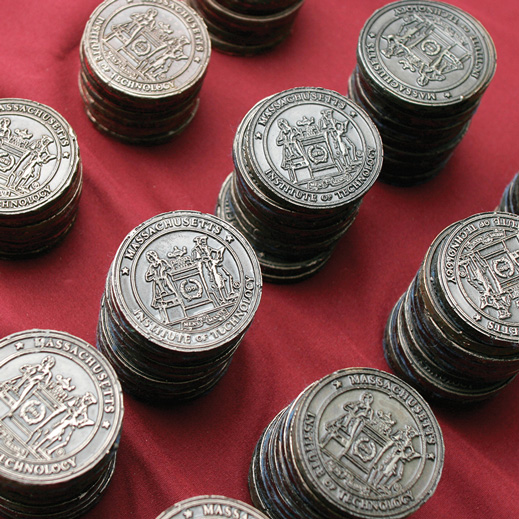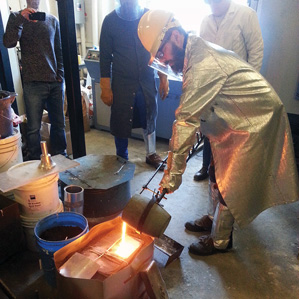A Labor of Love
When I think back to my time as a graduating Course 3 senior, I remember anxiously pacing the halls of my dorm at the end of May. How could there not be a problem set that was due tomorrow? Wasn’t there some midterm exam coming up? Fourteen years later, that feeling has not completely gone away.

But now, as a lecturer in the Department of Materials Science and Engineering (DMSE) and director of the department’s foundry, I spend the latter part of May pacing the halls worrying about other things: cleaning up the semester’s worth of disaster in the lab spaces I manage, and finishing about 150 cast medallions of the MIT seal that we give to our graduating students at commencement.
DMSE professor Krystyn Van Vliet came up with the idea of casting medallions for commencement when she was a graduate student in 2001. At first, grad students made all of them. Although I now lead and organize the process, it has evolved into a joint—and, I’d like to think, community-building—effort involving teaching staff and undergraduates as well.
During IAP, I start gathering students willing to donate their time and begin training them in the steps of what’s known as investment (or lost-wax) casting. First we produce and assemble wax copies of the MIT seal, made from a silicone rubber mold of an original medallion. Then we coat these assemblies with ceramic mold material, burn out the wax, and pour molten metal into the cavity left behind. Finally, the students finish the castings—cutting, grinding, polishing, and applying chemical patinas. The allure of molten metal is hard to resist, so the pouring is always the big draw. We cast the medallions in silicon bronze (4 percent silicon, 1 percent manganese, and 95 percent copper by weight) and pour at about 1,100 °C. But while any metal pour is a spectacle, that’s the easy part. It’s the finishing work that really differentiates a great foundry from a good one. People new to metal casting are always surprised that there’s more work to be done after the metal has been poured than before. I estimate that each medallion requires more than one hour of work, all told.

To keep the free labor flowing, I try to make the medallion-making sessions fun—students come and go as they wish, we listen to the radio, and we try to keep things lighthearted. Sometimes I have more help than I know what to do with, and sometimes it’s just a student or two. That’s fine with me, because I am happy to be exposing students to the foundry and getting them some hands-on experience. Although each handmade medallion winds up having its own quirks and merits, teaching students the process is more important than the end product.
I believe all graduates of a materials science program should get to try metal casting. It is one of the foundational elements of our field and a critical technology in the history of human civilization. It makes so many fundamental principles of science and engineering clear, immediate, and tangible. And with materials science curricula and American industry evolving away from metallurgy, our medallion-making project might be many students’ only chance to see molten metal in person.
Helping students cast the medallions—and seeing the students pick them up at a post-commencement reception—is one of the most rewarding things I do in an academic year. As early as March, I get stopped in the halls: “When do we get our medallions?” After graduation, I get e-mails from students scattered all over the world: “I didn’t get my medallion at Commencement—can you mail it to me?” Or “I’m going to be in town on August 5—can I pick up my medallion then?” It’s important to the students. For many of them, the medallion represents what they’ve gone through to finish their degrees, and it will always remind them of their experience at MIT and as members of DMSE. As the Course 3 version of the brass rat, the medallion marks the end of their journey.
Michael Tarkanian ’00, SM ’03, a lecturer in the Department of Materials Science and Engineering, has overseen the making of the DSME medallions since 2006.
Keep Reading
Most Popular
Large language models can do jaw-dropping things. But nobody knows exactly why.
And that's a problem. Figuring it out is one of the biggest scientific puzzles of our time and a crucial step towards controlling more powerful future models.
How scientists traced a mysterious covid case back to six toilets
When wastewater surveillance turns into a hunt for a single infected individual, the ethics get tricky.
The problem with plug-in hybrids? Their drivers.
Plug-in hybrids are often sold as a transition to EVs, but new data from Europe shows we’re still underestimating the emissions they produce.
Google DeepMind’s new generative model makes Super Mario–like games from scratch
Genie learns how to control games by watching hours and hours of video. It could help train next-gen robots too.
Stay connected
Get the latest updates from
MIT Technology Review
Discover special offers, top stories, upcoming events, and more.